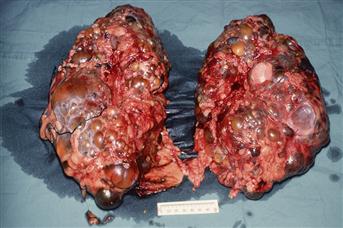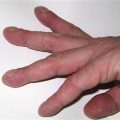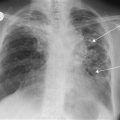Abdominal Swellings
Abdominal swellings may be divided into generalised and localised swellings. Abdominal swellings are a common surgical problem. They are also frequently the subject of examination questions! Generalised swellings are classically described as the ‘five Fs’, namely fat, faeces, flatus, fluid or fetus. For the purpose of description of localised swellings, the abdomen has been divided into seven areas, i.e. right upper quadrant, left upper quadrant, epigastrium, umbilical, right lower abdomen, left lower abdomen and suprapubic area. Hepatomegaly, splenomegaly and renal masses, although referred to in this section, are dealt with under the relevant heading in the appropriate section of the book.
Right Upper Quadrant
History
Liver
See hepatomegaly, p. 229.
Gall bladder
Known history of gallstones. History of flatulent dyspepsia. Jaundice. Dark urine. Pale stools. Pruritus. Recent weight loss may suggest carcinoma of the head of the pancreas or carcinoma of the gall bladder.
Right colon
Lassitude, weakness, lethargy suggesting anaemia from chronic blood loss. Central abdominal colicky pain, vomiting and constipation and change in bowel habit will suggest colonic carcinoma. There may be a history of gross constipation to suggest faecal loading. Known history of diverticular disease. History of attacks of crying, abdominal pain and blood and mucus in the stool (‘redcurrant jelly’ stool) will suggest intussusception in infants.
Right kidney
See kidney swellings, p. 299.
Examination
Gall bladder
A mucocele is either non-tender or only mildly tender. It is large and smooth and moves with respiration, projecting from under the ninth costal cartilage at the lateral border of rectus abdominis. Empyema presents with an acutely tender gall bladder, which is difficult to define due to pain and tenderness. The patient may be jaundiced due to Mirizzi syndrome (external pressure from a stone impacted in Hartmann’s pouch on the adjacent bile duct). Carcinoma of the gall bladder may present as a hard, irregular mass in the right hypochondrium, but normally presents as obstructive jaundice due to secondary deposits in the nodes at the porta hepatis causing external compression of the hepatic ducts. A smooth enlarged gall bladder in the presence of jaundice may be due to carcinoma of the head of the pancreas (Courvoisier’s law: ‘in the presence of obstructive jaundice, if the gall bladder is palpable, the cause is unlikely to be due to gallstones’).
Right colon
Faeces are usually soft and putty-like and can be indented but may also feel like a mass of rocks. Carcinoma is usually a firm to hard irregular mass, which may be mobile or fixed. A diverticular mass is usually tender and ill-defined, unless there is a large paracolic abscess. With caecal volvulus, there is a tympanitic mass which may be tender with impending infarction. With intussusception, there will be a smooth, mobile tender sausage-shaped mass in the right hypochondrium. The mass may move as the intussusception progresses.
Right kidney
See kidney swellings, p. 299.
General Investigations
■ FBC, ESR
Hb ↓ anaemia, e.g. carcinoma of the colon, haematuria with renal lesions. Hb ↑, e.g. hypernephroma (polycythaemia associated with hypernephroma). WCC ↑, e.g. empyema, diverticular mass. ESR ↑, malignancy.
■ U&Es
Vomiting and dehydration, e.g. gall bladder and bowel lesions. Ureteric obstruction with renal lesions leading to uraemia.
■ LFTs
Liver lesions. Secondary deposits in liver.
■ MSU
Renal lesions – red blood cells, pus cells, malignant cells. C&S.
■ AXR
Intestinal obstruction due to carcinoma of the large bowel. Gallstones (10% are radio-opaque). Caecal volvulus. Constipation. Calcification in renal lesions.
■ US
Liver lesions. Gallstones. Mucocele. Empyema. Bile duct dilatation.
Specific Investigations
History
Spleen
See splenomegaly, p. 425.
Stomach
Vomiting will suggest pyloric stenosis, acute dilatation of the stomach and carcinoma. Vomiting food ingested several days previously suggests pyloric stenosis. Lethargy, loss of appetite and weight loss are seen in carcinoma of the stomach.
Pancreas
There may be a history of acute pancreatitis, which would suggest the development of a pseudocyst. Weight loss, backache and jaundice will suggest carcinoma of the pancreas. Recent onset of diabetes may occur with carcinoma of the pancreas.
Kidney
See kidney swellings, p. 299.
Colon
Lower abdominal colicky pain and change in bowel habit may suggest carcinoma or diverticular disease. A long history of constipation may suggest faecal masses.
Examination
Stomach
Gastric distension may present with a vague fullness and a succussion splash. Carcinoma will present with a hard, craggy, immobile mass. Pancreatic tumours may be impalpable or present as a fixed mass, which does not move with respiration. Pancreatic pseudocysts are often large, smooth and may be tender.
Colon
See right upper quadrant, p. 11.
General Investigations
■ FBC, ESR
Hb ↓ carcinoma. Hb ↑ hypernephroma (polycythaemia is associated with hypernephroma). WCC ↑ diverticular disease, renal infections.
■ U&Es
Vomiting, dehydration (with gastric and colonic lesions). Renal lesions.
■ LFTs
Liver lesions. Secondary deposits in liver.
Specific Investigations
■ Blood glucose
May be raised in pancreatic carcinoma.
■ Barium enema
Carcinoma. Diverticular disease.
■ Colonoscopy
Carcinoma. Diverticular disease.
■ Gastroscopy
Carcinoma of the stomach. Pyloric stenosis.
■ CT
Carcinoma of the pancreas. Pancreatic pseudocyst. Liver secondaries. Splenomegaly. Paracolic abscess.
Epigastrium
Many of the swellings that occur here will have been described under swellings in other regions of the abdomen. Although a full list of epigastric swellings is given below, only those not referred to in other sections will be discussed in the history and examination sections.
History
Abdominal wall
The patient may indicate a soft, subcutaneous swelling, which may be a lipoma or an epigastric hernia containing extraperitoneal fat. The latter always occurs in the midline through a defect in the linea alba. They may become strangulated, in which case they are tender, and occasionally the skin is red. Occasionally a patient may indicate a firm bony lump in the upper epigastrium, which is in fact a normal xiphisternum. This may have become apparent due to either a deliberate attempt to lose weight or sudden weight loss as a result of underlying disease. Metastatic deposits may present as single or multiple fixed lumps in the skin or subcutaneous tissue, e.g. from breast or bronchus.
Stomach
A baby may present with projectile vomiting. The infant thrives for the first 3–4 weeks of life and then develops projectile vomiting after feeds. The first-born male child in a family is most commonly affected. There may be a history of a familial tendency, especially on the maternal side.
Retroperitoneum
A history of backache may suggest an aortic aneurysm or the patient may complain of a pulsatile epigastric swelling. Backache may also be a presenting symptom of retroperitoneal lymphadenopathy.
Examination
Abdominal wall
A soft, lobulated mass suggests a lipoma. It will be mobile over the tensed abdominal musculature. A fatty, occasionally tender, non-mobile swelling in the midline will suggest an epigastric hernia. The majority of epigastric hernias are composed of extraperitoneal fat, although there may be a sac with bowel contents. A cough impulse will be palpable. The swelling may be reducible. Hard, irregular, fixed lumps in the abdominal wall suggest metastatic deposits, especially if there is a history of carcinoma of the breast or bronchus.
Retroperitoneum
An aneurysm presents as a pulsatile expansile mass. Check the distal circulation (emboli, associated peripheral ischaemia). Retroperitoneal lymph node metastases from testicular cancer may present as a large retroperitoneal mass. Check the testes for swellings. Check all other sites for lymphadenopathy (especially the left supraclavicular node). Lymphadenopathy may also result from lymphoma. Check for lymphadenopathy elsewhere and for splenomegaly. A hard, craggy, mobile mass, especially in the presence of ascites, suggests omental secondaries (ovary, stomach – check for Virchow’s node, i.e. left supraclavicular node).
General Investigations
Specific Investigations
■ Blood glucose
May be abnormal with pancreatic carcinoma or previous pancreatitis.
■ CT
Pancreatic tumours. Pancreatic pseudocyst. Lymphadenopathy. Aortic aneurysm. Omental deposits. Guided biopsy/FNAC.
■ Barium enema
Carcinoma of the colon. Diverticular disease.
■ Colonoscopy
Carcinoma of the colon. Diverticular disease.
■ Gastroscopy
Carcinoma of the stomach.
■ Laparoscopy
Carcinoma of the ovaries. Omental secondaries. Carcinomatosis peritonei.
■ Biopsy.
Umbilical
Many of the swellings here will already have been described under swellings in other regions of the abdomen. Only those not referred to in those sections will be discussed in the history and examination sections.
History
Superficial
Sister Joseph’s nodule presents as a hard lump at the umbilicus. It is due to secondary deposits of carcinoma of the stomach, colon, ovary or breast.
Hernia
An umbilical hernia presents in infancy as an umbilical swelling which is reducible, and will usually have been noted at birth. Paraumbilical hernias usually occur in obese adults, often female. The patient may have had a lump for a long time. It may present with incarceration or with a tender painful swelling, suggesting strangulation.
Small bowel
The patient may present with central abdominal colicky pain, vomiting and diarrhoea, suggestive of Crohn’s disease or more rarely a carcinoma of the small bowel.
Examination
Superficial
Sister Joseph’s nodule presents as a hard lump or lumps at the umbilicus. Check for carcinoma of the stomach, colon, ovary or breast.
Hernia
In infants, there may be an obvious large umbilical defect. The swelling is usually wide-necked and reducible. In adults, there may be a reducible paraumbilical hernia. Occasionally it is soft, containing extraperitoneal fat. Frequently, there is a sac containing omentum. Incarceration may occur. A tender red swelling suggests strangulation. A Richter’s-type hernia may occur at this site.
Small bowel
Small bowel masses are usually very mobile, may be sausage-shaped, and may be tender.
General Investigations
Specific Investigations
■ CT
Aortic aneurysm. Retroperitoneal lymphadenopathy. Omental deposits. Guided biopsy/FNAC.
■ Barium enema
Carcinoma of the colon. Diverticular disease.
■ Colonoscopy
Carcinoma of the colon. Diverticular disease.
■ Gastroscopy
Carcinoma of the stomach.
■ Small bowel enema
Crohn’s disease. Lymphoma. Carcinoma.
■ Laparoscopy
Carcinoma of the ovaries. Omental secondaries. Carcinomatosis peritonei.
History
Anterior abdominal wall
The patient may have the development of a soft mass that is slow growing, suggestive of a lipoma. A spigelian hernia occurs just lateral to the rectus muscle, halfway between the umbilicus and symphysis pubis. It is usually reducible.
Large bowel
A short history of central abdominal, colicky pain followed by a sharply localised pain in the right iliac fossa will suggest the diagnosis of acute appendicitis. After 48 hours, if there is not generalised peritonitis, an appendix mass will have formed and an abscess may subsequently form in the right iliac fossa. With carcinoma of the caecum, the patient will either have noticed a mass or will present with alteration in bowel habit and the symptoms of anaemia, e.g. tiredness, lethargy. The same applies to carcinoma of the ascending colon. Faeces will be indentable and hard, rock-like masses will be felt around the colon. Caecal volvulus will present with central abdominal colicky pain and abdominal distension. Intussusception is more common in infants and usually presents with colicky abdominal pain and the classic ‘redcurrant jelly’ stool. Crohn’s disease will present with malaise and diarrhoea with central abdominal colicky pain.
Carcinoma of the sigmoid colon will present with lower abdominal colicky pain, a change in bowel habit and bleeding PR. Diverticular disease may present with similar symptoms. Sigmoid volvulus will present with lower abdominal colicky pain and a tense, palpable mass in the left abdomen, which is tympanitic on percussion. Large bowel Crohn’s disease will present with a sausage-like, palpable mass, which may be tender and is associated with diarrhoea.
Small bowel
If there is a mass palpable in the right iliac fossa, the site of pathology is likely to be in the terminal ileum. This usually involves central abdominal colicky pain and a change in bowel habit. Ileo-caecal TB causes abdominal pain, diarrhoea which is associated with malaise and weight loss.
Spleen
With massive splenomegaly, the spleen may be palpable extending into the right lower quadrant.
Ovary/fallopian tube/uterus
The patient herself may feel a lump in the abdomen (ovarian cyst, fibroid) or notice generalised abdominal swelling, which may be associated with a massive ovarian cyst or ascites associated with ovarian cancer. Ectopic pregnancy will present with a missed period and abdominal pain, bleeding PV, and collapse with hypovolaemic shock if it ruptures. Salpingo-oophoritis will present with lower abdominal pain and tenderness and associated fever, and often a purulent vaginal discharge. Menorrhagia, lower abdominal pain and dyspareunia may suggest fibroids.
Retroperitoneum
The patient may present having noticed a pulsatile swelling in the iliac fossa. Pelvic lymphadenopathy may be suspected by history of removal of a malignant lesion from the lower limb, especially malignant melanoma. There may be an existing lesion present on the limb. A dull, boring pain may be suggestive of an iliac bone lesion. A palpable bony lesion suggests an osteogenic sarcoma or Ewing’s tumour of bone.
Examination
The features of most of the lesions described above have been described in the other sections on abdominal swellings. Only those findings relevant to the ovary, uterus and fallopian tube will be described here. Examination may reveal a greatly distended abdomen, which may be due to a huge ovarian cyst or ascites associated with an ovarian neoplasm. Huge ovarian cysts are often smooth and loculated. It is impossible to get below them as they arise out of the pelvis. Signs of ascites include shifting dullness and a fluid thrill. With ectopic pregnancy, there may be a palpable mass in either iliac fossa. This may be associated with shock if rupture of the ectopic pregnancy has occurred. Shoulder-tip pain may occur from irritation of the undersurface of the diaphragm with blood. With tubo-ovarian abscess, there may be a palpable mass arising out of the pelvis, or merely lower abdominal tenderness. Vaginal examination will reveal tenderness in the pouch of Douglas. Uterine fibroids may be extremely large and palpable as nodules on the underlying uterus.
General Investigations
■ FBC, ESR
Hb ↓ Crohn’s disease, carcinoma. ESR ↑ carcinoma, Crohn’s disease, ileo-caecal TB. WCC ↑ appendicitis, diverticulitis.
■ U&Es
Vomiting. Dehydration. Obstruction from carcinoma or Crohn’s disease.
■ LFTs
Alkaline phosphatase ↑ with liver secondaries.
■ US
Ovarian lesions. Uterine lesions. Tubo-ovarian abscesses.
Pregnancy. Ectopic pregnancy. Iliac artery aneurysms.
Lymphadenopathy. Appendix mass. Crohn’s mass.
■ AXR
Obstruction. Dilated loops of bowel. Ovarian teratoma (teeth, etc.). Erosion of iliac bone – bone tumours.
Specific Investigations
■ CT
Ovarian lesions. Uterine lesions. Abscess. Ectopic pregnancy. Iliac artery aneurysm. Lymphadenopathy. Appendix mass. Bone tumours.
■ Barium enema
Carcinoma. Diverticular disease.
■ Small bowel enema
Crohn’s disease. Carcinoma. Lymphoma.
■ Colonoscopy
Carcinoma (biopsy). Diverticular disease.
History
Bladder
Sudden onset of suprapubic pain with inability to pass urine suggests acute retention. There will usually be a past history of difficulty in starting and a poor stream. A history of dribbling may suggest acute renal failure associated with upper tract problems from chronic outflow obstruction. Haematuria, frequency or dysuria may suggest bladder carcinoma.
Uterus
Missed periods and early morning vomiting will suggest pregnancy. Menorrhagia and dyspareunia will suggest fibroids. Intermenstrual bleeding suggests carcinoma.
Urachus
Umbilical discharge may suggest a urachal cyst or abscess.
Examination
In acute retention, there will be a smooth, tender swelling extending towards (but not above) the umbilicus. It is dull to percussion and it is impossible to get below it. Digital rectal examination will usually reveal benign prostatic hypertrophy or occasionally a hard, irregular prostate associated with carcinoma. With carcinoma of the bladder, a hard, irregular craggy mass may be felt arising out of the pelvis.
Uterus
A smooth, regular swelling arising out of the pelvis suggests a pregnant uterus. Later, as the uterus enlarges, fetal heart sounds may be heard. Fibroids are usually smooth and firm and may become very large. Uterine carcinoma is hard and craggy. Bimanual examination may confirm the diagnosis.






